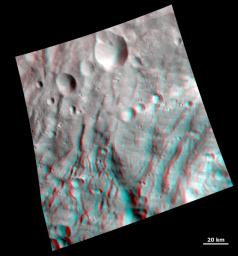
|
3-D Image of Grooves and Wrinkles in the South Polar Region
- Click the image above for a larger view
- Full-Res JPEG (1072 x 1155) (111.4 kB)
- Full-Res TIFF (1072 x 1155) (3.7 MB)
Caption:
NASA's Dawn spacecraft obtained this 3-D image of Vesta with its framing camera on Aug. 23 and 28, 2011. This image of the south polar region was taken through the camera's clear filter at a distance of 1,700 miles (2,740 kilometers). The image has a resolution of about 260 meters per pixel. Use red-cyan (red-blue, or red-green) glasses for a 3-D view of the image.
Background Info:
The Dawn mission to Vesta and Ceres is managed by NASA's Jet Propulsion Laboratory, a division of the California Institute of Technology, Pasadena, Calif., for NASA's Science Mission Directorate, Washington. UCLA is responsible for overall Dawn mission science. The Dawn framing cameras were developed and built under the leadership of the Max Planck Institute for Solar System Research, Katlenburg-Lindau, Germany, with significant contributions by DLR German Aerospace Center, Institute of Planetary Research, Berlin, and in coordination with the Institute of Computer and Communication Network Engineering, Braunschweig. The Framing Camera project is funded by the Max Planck Society, DLR, and NASA/JPL.
More information about Dawn is online at http://www.nasa.gov/dawn and http://dawn.jpl.nasa.gov .
Cataloging Keywords:
| Name | Value | Additional Values |
|---|---|---|
| Target | 4 Vesta | |
| System | Main Belt | |
| Target Type | Asteroid | |
| Mission | Dawn | |
| Instrument Host | Dawn | |
| Host Type | Orbiter | |
| Instrument | Framing Camera (FC) | |
| Detector | ||
| Extra Keywords | Color | |
| Acquisition Date | ||
| Release Date | 2011-09-27 | |
| Date in Caption | ||
| Image Credit | NASA/JPL-Caltech/UCLA/MPS/DLR/IDA | |
| Source | photojournal.jpl.nasa.gov/catalog/PIA14790 | |
| Identifier | PIA14790 | |
